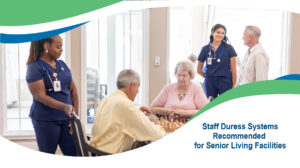Staff Duress Systems Recommended for Senior Living Communities
Adding a staff duress system for caregivers in senior living communities is a good idea because some residents with Alzheimer’s or other types of dementia may experience significant personality changes, which can include irritable or aggressive behavior.
According to a CNN report, about 5% to 10% of Alzheimer’s patients may show violent behavior. Medical News Today indicates that aggression is not limited to a single stage of dementia and can appear at any time with any form of dementia. According to a 2020 review, 90% of people living with dementia experience behavioral or psychological symptoms such as aggression.
The percentage of senior living residents with Alzheimer’s or dementia is significant. According to the Alzheimer’s Association’s 2020 Alzheimer’s Disease Facts and Figures report, 48% of nursing home residents are living with Alzheimer’s or other dementias. Additionally, among older adults in residential communities, including assisted living, 42% or more have some form of Alzheimer’s or other dementias.
Better safe than sorry is the way to go when protecting healthcare workers and residents alike. A staff duress system ensures a quick response for emergencies when staff needs backup stat.
It’s important to emphasize a holistic approach that includes both technology and human elements to ensure the safety and security of staff and residents in senior living or memory care units.
Caregivers should have proactive strategies for de-escalation to prevent violence and regular drills and testing to keep the duress system and staff prepared.
De-escalation strategies for Alzheimer’s patients are crucial in preventing violence and ensuring the safety and well-being of both patients and caregivers. Here are some effective techniques:
- Back Off and Ask Permission: Give the person space and avoid crowding them. Always ask for permission before doing something that involves them.
- Use Calm, Positive Statements: Speak in a soft, reassuring tone and use positive language to convey your message.
- Reassure and Slow Down: Offer comfort and reassurance. Move slowly to avoid startling the person.
- Add Light: Ensure the environment is well-lit to help the person feel secure and oriented.
- Offer Guided Choices: Provide simple options between two things to help give a sense of control.
- Focus on Pleasant Events: Redirect attention to enjoyable activities or memories.
- Offer Simple Exercise Options: Engage the person in light physical activity to help reduce anxiety.
- Limit Stimulation: Reduce noise and clutter to prevent overstimulation.
- Understand Body Language: Be aware of your own body language and that of the person with dementia. Non-threatening body language can help calm the situation.
- Validation: Acknowledge the person’s feelings and experiences to help them feel understood.
- Mitigate Risks: Remove any objects that could be used aggressively.
- Use Distractions: Introduce a favorite snack, music, or TV show to divert attention from the source of agitation.
These strategies can help manage patients safely by meeting their immediate needs and reducing the risk of escalation. It’s important to tailor your approach to the individual, as each person may respond differently to various techniques.
Response Protocol
It is also a good idea for caregivers to have a detailed action plan for different types of emergencies and staff roles and responsibilities during a duress alert.
Staff roles and responsibilities are critical during a duress event to ensure a swift and effective response. Here are some key responsibilities:
- Immediate Notification: Staff should activate the duress alarm to alert security personnel or emergency services as soon as a threat is identified.
- Safety First: The primary responsibility is to ensure the safety of all individuals involved, including themselves, other staff, and any clients or patients.
- Follow Protocol: Staff must follow the established duress policies and procedures, which should be well-defined and practiced regularly.
- Coordination: There should be a coordinated effort among all staff members, which includes clear communication and predefined roles during the emergency.
- Support: Staff should provide support to each other, helping to manage the situation and assist any individuals who may be affected by the duress event.
- De-escalation: If trained and safe to do so, staff may attempt to de-escalate the situation using approved techniques.
- Reporting: After the situation is under control, staff should report the incident in detail according to the organization’s reporting procedures.
It’s essential for organizations to have these roles and responsibilities clearly outlined and for staff to be trained on them to ensure everyone’s safety during a duress alert.
Staff Duress System
Help Alert® by RFT is a wireless BLE/LoRa, 24/7 mobile staff duress solution that integrates with existing technology systems to quickly and accurately pinpoint staff in any situation both inside and outside a senior living community or building.
The wireless non-WIFI system components include:
- Wearable badges for staff with distress buttons.
- Both low and high-priority buttons.
- Real-time location tracking for precise and swift assistance.
- Integration with existing communication systems for immediate alerts.
- Inside and outside coverage for all buildings and grounds using a blend of BLE/LoRa hubs and gateways.
- Reporting capabilities are built into the system.
Conclusion
It’s important to have a wireless staff duress system in senior living communities due to almost half of all residents living with Alzheimer’s or some form of dementia. A holistic approach is needed to de-escalate and respond to duress events that include both technology and human elements to ensure the safety and security of staff and residents.




